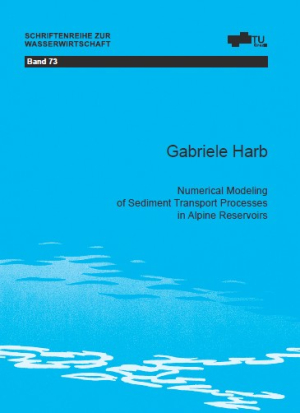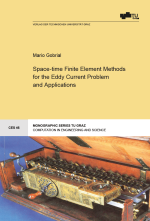Sedimentation processes are in a „dynamic balance“ in most natural rivers, but the construction of dams and reservoirs influences these natural conditions. The flow velocities, turbulences and bed shear stresses in reservoirs are reduced compared to free flow conditions, which lead to the deposition of the transported sediment particles. As a further consequence the sediment depositions reduce the storage volume by „filling up“ the reservoir. This „reservoir sedimentation“ is a problem in many Alpine reservoirs.
This thesis focus on the sediment deposition problems and the sediment transport processes in reservoirs of river power plants with a small storage volume compared to the annual inflow. The aims are the improvement of the sediment management in Alpine reservoirs and the analysis of the effect of sediment deposition in reservoirs on the operation of the reservoir and the flood protection of the surrounding area. This aims require the knowledge of sedimentation, erosion and sediment transport processes together with field measurements and an adequate model to assess the impact of the selected sediment management method.
Two different three-dimensional computational fluid dynamic programs were used to simulate the sediment transport processes and effects during flushing and flood events in two Alpine river reservoirs. The results of the simulations were calibrated and validated with measurements conducted in the prototype or in the physical model test. Several sediment transport algorithm were tested and validated with the measured bed changes. The simulated bed changes and sediment transport processes showed a good correlation with the measurements. The effects of sediment depositions and the remobilization of deposited sediment in reservoirs could be analysed. Based on the results of the numerical modelling it is possible to recommend sediment management strategies for small Alpine reservoirs.
Ausgabe: Open Access E-Book
ISBN: 978-3-85125-452-5
Umfang: 246 Seiten
Sprache: Englisch
Erschienen: August 2016
Reihe: Schriftenreihe zur Wasserwirtschaft, Band 73
Sedimentation processes are in a „dynamic balance“ in most natural rivers, but the construction of dams and reservoirs influences these natural conditions. The flow velocities, turbulences and bed shear stresses in reservoirs are reduced compared to free flow conditions, which lead to the deposition of the transported sediment particles. As a further consequence the sediment depositions reduce the storage volume by „filling up“ the reservoir. This „reservoir sedimentation“ is a problem in many Alpine reservoirs.
This thesis focus on the sediment deposition problems and the sediment transport processes in reservoirs of river power plants with a small storage volume compared to the annual inflow. The aims are the improvement of the sediment management in Alpine reservoirs and the analysis of the effect of sediment deposition in reservoirs on the operation of the reservoir and the flood protection of the surrounding area. This aims require the knowledge of sedimentation, erosion and sediment transport processes together with field measurements and an adequate model to assess the impact of the selected sediment management method.
Two different three-dimensional computational fluid dynamic programs were used to simulate the sediment transport processes and effects during flushing and flood events in two Alpine river reservoirs. The results of the simulations were calibrated and validated with measurements conducted in the prototype or in the physical model test. Several sediment transport algorithm were tested and validated with the measured bed changes. The simulated bed changes and sediment transport processes showed a good correlation with the measurements. The effects of sediment depositions and the remobilization of deposited sediment in reservoirs could be analysed. Based on the results of the numerical modelling it is possible to recommend sediment management strategies for small Alpine reservoirs.






